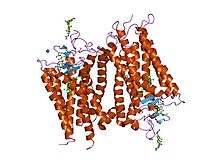Rhodopsin-like receptor
| Rhodopsin-like receptors | |||||||||
|---|---|---|---|---|---|---|---|---|---|

Structure of rhodopsin: A G protein-coupled receptor.
|
|||||||||
| Identifiers | |||||||||
| Symbol | 7tm_1 | ||||||||
| Pfam | PF00001 | ||||||||
| InterPro | IPR000276 | ||||||||
| PROSITE | PDOC00211 | ||||||||
| SCOP | 1f88 | ||||||||
| SUPERFAMILY | 1f88 | ||||||||
| OPM superfamily | 6 | ||||||||
| OPM protein | 1gzm | ||||||||
|
|||||||||
| Available protein structures: | |
|---|---|
| Pfam | structures |
| PDB | RCSB PDB; PDBe; PDBj |
| PDBsum | structure summary |
Rhodopsin-like receptors are a family of proteins that comprise the largest group of G protein-coupled receptors.
G-protein-coupled receptors, GPCRs, constitute a vast protein family that encompasses a wide range of functions (including various autocrine, paracrine, and endocrine processes). They show considerable diversity at the sequence level, on the basis of which they can be separated into distinct groups. GPCRs are usually described as "superfamily" because they embrace a group of families for which there are indications of evolutionary relationship, but between which there is no statistically significant similarity in sequence. The currently known superfamily members include the rhodopsin-like GPCRs (this family), the secretin-like GPCRs, the cAMP receptors, the fungal mating pheromone receptors, and the metabotropic glutamate receptor family. There is a specialised database for GPCRs.
The rhodopsin-like GPCRs themselves represent a widespread protein family that includes hormones, neurotransmitters, and light receptors, all of which transduce extracellular signals through interaction with guanine nucleotide-binding (G) proteins. Although their activating ligands vary widely in structure and character, the amino acid sequences of the receptors are very similar and are believed to adopt a common structural framework comprising 7 transmembrane (TM) helices.
Rhodopsin-like GPCRs have been classified into the following 19 subgroups (A1-A19) based on a phylogenetic analysis.
...
Wikipedia
